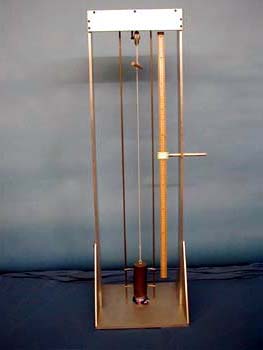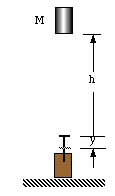Demos: 1M-05 Pile Driver

This demonstration illustrates the connection between work and energy. A large mass (the pile) is raised to a known height, then allowed to fall freely (almost--the guide rails have a small amount of friction). The pile strikes a nail embedded in a block of wood and drives it into the wood a distance y. Except for losses (small) that occur as a result of the inelastic collision between the pile and nail, the potential energy of the pile is transformed into work driving the nail. The work-energy relationship gives us

where f is the average friction force between the nail and the wood.
Directions: Place the block with the nail in such a position that the pile will strike it solidly. Pull the pile to a known height (a cm scale is on the scaffolding) and release it. If you are doing the experiment quantitatively, record the appropriate distances.
Suggestions for Presentation: As in 1M - 4, lead the students in the direction that this analysis appears to be a two-step process; potential energy changes to kinetic energy, kinetic energy changes to work. However, the work-energy relationship allows us to look at end points only.
(This demonstration can be presented as a qualitative look at energy-work relationships. Rather than take measurements, just emphasize the energy transformations and use the demo as a visual aid.)
Applications: The obvious one is the pile driver used in driving pilings deep into the ground. In real situations, the object being driven into ground will likely have substantial mass compared with the pile, so the analysis above is only an approximation.
Last Updated: Nov 30, 2023 11:25 AM